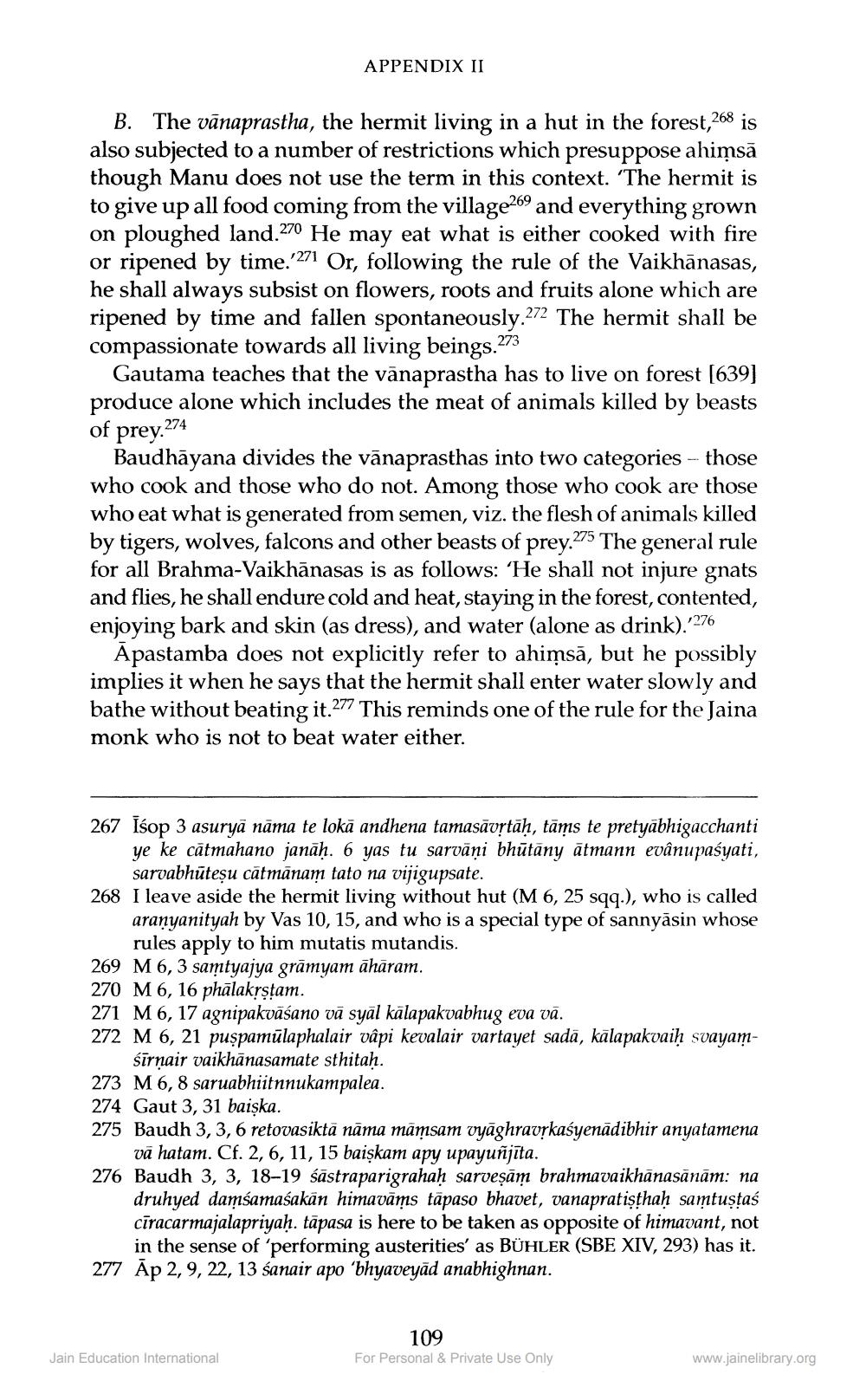________________
APPENDIX II
B. The vānaprastha, the hermit living in a hut in the forest,268 is also subjected to a number of restrictions which presuppose ahimsā though Manu does not use the term in this context. 'The hermit is to give up all food coming from the village269 and everything grown on ploughed land.270 He may eat what is either cooked with fire or ripened by time.'271 Or, following the rule of the Vaikhānasas, he shall always subsist on flowers, roots and fruits alone which are ripened by time and fallen spontaneously.272 The hermit shall be compassionate towards all living beings.273
Gautama teaches that the vānaprastha has to live on forest (639) produce alone which includes the meat of animals killed by beasts of prey.274
Baudhāyana divides the vānaprasthas into two categories -- those who cook and those who do not. Among those who cook are those who eat what is generated from semen, viz. the flesh of animals killed by tigers, wolves, falcons and other beasts of prey.275 The general rule for all Brahma-Vaikhānasas is as follows: 'He shall not injure gnats and flies, he shall endure cold and heat, staying in the forest, contented, enjoying bark and skin (as dress), and water (alone as drink)."276
Apastamba does not explicitly refer to ahimsā, but he possibly implies it when he says that the hermit shall enter water slowly and bathe without beating it.277 This reminds one of the rule for the Jaina monk who is not to beat water either.
267 Isop 3 asuryā nāma te lokā andhena tamasāvrtāḥ, tāms te pretyābhigacchanti
ye ke cătmahano janāḥ. 6 yas tu sarvāṇi bhūtāny ātmann evânupaśyati,
sarvabhūtesu cātmānam tato na vijigupsate. 268 I leave aside the hermit living without hut (M 6,25 sqq.), who is called
aranyanityah by Vas 10, 15, and who is a special type of sannyāsin whose
rules apply to him mutatis mutandis. 269 M6, 3 samtyajya grāmyam āhāram. 270 M 6, 16 phālakrstam. 271 M6, 17 agnipakvāśano vā syāl kalapakvabhug eva vā. 272 M 6, 21 puşpamūlaphalair vâpi kevalair vartayet sadā, kālapakvaiḥ svayam
śīrnair vaikhānasamate sthitaḥ. 273 M6, 8 saruabhiitnnukampalea. 274 Gaut 3, 31 baiska. 275 Baudh 3,3,6 retovasiktā nāma māmsam vyāghravskaśyenādibhir anyatamena
vā hatam. Cf. 2, 6, 11, 15 baiskam apy upayuñjīta. 276 Baudh 3, 3, 18-19 śāstraparigrahaḥ sarveşām brahmavaikhānasānām: na
druhyed damśamasakan himavāms tāpaso bhavet, vanapratişthaḥ samtuştaś cīracarmajalapriyaḥ, tāpasa is here to be taken as opposite of himavant, not
in the sense of performing austerities' as BÜHLER (SBE XIV, 293) has it. 277 Ap 2,9, 22, 13 śanair apo 'bhyaveyād anabhighnan.
Jain Education International
109 For Personal & Private Use Only
www.jainelibrary.org




